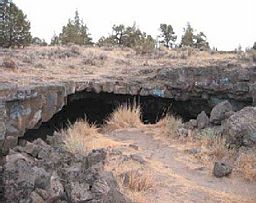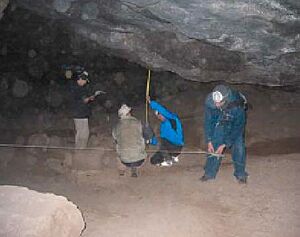Redmond Caves facts for kids
Quick facts for kids Redmond Caves |
|
|---|---|

Entrance to Redmond Cave no. 1
|
|
| Location | Deschutes County, Oregon, U.S. |
| Geology | Horse Cave lobe; basalt of Lava Top Butte |
| Entrances | 6 |
| List of entrances |
Each cave has one entrance, except Cave Next Door has two |
| Difficulty | Easy to Moderate |
| Access | Public |
| Cave survey | 1997-06-07; 1980-11-??; 1969-03-28 |
The Redmond Caves are a group of six lava tubes located in Deschutes County, Oregon, United States. A lava tube is like a natural tunnel formed by flowing lava during a volcanic eruption. When the outside of a lava flow cools and hardens, the hot lava inside keeps flowing, creating a hollow tube.
These caves are found right in the city of Redmond. The city and the Bureau of Land Management (BLM) work together to take care of them. Five of the caves are inside the Redmond Caves Park and have been known by local people for a very long time. The Redmond Caves are part of a much bigger system of lava tubes called the Horse Lava Tube System. They are the northernmost part of this system. The lava flow that created these caves happened about 80,000 years ago!
Contents
Discovering the Caves
Native Americans knew about many caves in this area a long, long time ago, even before recorded history. We know this because they left behind artifacts (old tools and items) inside the caves.
The Redmond Caves might have been some of the first caves in Central Oregon that European settlers discovered. In the 1870s, an old stagecoach road passed right by them. Over the years, people thought about using the caves for different things. For example, in the 1910s, some thought they could be good for storing potatoes. Someone else even wanted to grow mushrooms in them!
The Lions Club Discovery
In 1954, the Redmond Lions Club helped open up an entrance to a cave that no one could get into before. After they finally got inside, they found footprints from modern shoes in the dusty floor. It turned out that two boys had squeezed into the cave the night before!
This newly opened cave was the longest one there and shaped like a "Y." Later, the same two boys, Dick Nooe and Harry Sly, explored it more. They found out the "Y" shape was actually a loop.
Ancient Finds
After the new cave was found, John Berning from the Lions Club showed Dick Nooe and Harry Sly some old artifacts that came from inside the caves. The boys went back many times to dig through the dirt and volcanic ash. They found all sorts of ancient items.
However, they were told that collecting these items was against the Preservation of American Antiquities Act. This law protects important historical sites and artifacts. So, the boys gave their collections to the University of Oregon so they could be studied and preserved.
Caves as Shelters
In the 1960s, the caves were even considered as fallout shelters by the Office of Civil Defense. These shelters were places where people could go to be safe in case of an atomic attack, volcanic eruption, or earthquake. The three biggest caves were checked and could hold up to 450 people. In the early 1970s, people in Bend and Redmond received maps showing them how to get to these shelters.
Protecting the Caves
Over the years, many groups have worked to clean up the Redmond Caves. Sadly, the caves have sometimes been damaged by vandalism (graffiti and other harm). To help protect them, different projects have been created.
In 1997, a group called the Oregon High Desert Grotto helped survey and map all five caves in the park. In 2002, the BLM organized a big cleanup event. They removed 300 old tires and even a car from the park! Another cleanup happened in 2006 on National Public Lands Day. The Oregon High Desert Grotto and the Willamette Valley Grotto helped remove graffiti and trash.
Bat Habitats
Bats have been seen using the Redmond Caves at different times. It's thought that before many people started visiting, the caves were home to lots of bats.
In 1986, a bat biologist named Mark Perkins visited the caves. He saw only one hibernating Townsend's big-eared bat. During a summer visit, he again saw only one big-eared bat using the caves as a place to rest at night. However, he also found two other types of bats that hadn't been known to use the caves before: the big brown bat and the Western Small-footed Myotis. All the bats he saw were males.
The BLM has considered plans to help restore parts of the Redmond Caves to be better homes for bats.
Exploring the Caves
Today, the park has five main caves. However, in the past, there were more caves known around the area.
A very small cave called Airport Cave is located on the land next to the airport. It's only about 12 feet long.
Another cave, called Redmond Railroad Cave, was once known to exist near an old lumber mill. A person named Dick Nooe remembered digging westward in it and hearing a train rumbling overhead! This cave was later closed up by the lumber mill.
Similarly, a cave called Bank Cave was accidentally opened during the building of a parking lot. It was estimated to be 100 feet long and had shiny gypsum deposits on its floor. This cave was also closed up during construction.
Named Caves
Lions Cave was opened by the Redmond Lions Club in 1954 and was named after them by a local newspaper.
The six caves that exist today have two sets of names. The BLM uses numbers for them, and the others were named by caving clubs or the local newspaper.
- Airport Cave (Redmond Cave no. 6)
- Lions Cave (Redmond Cave no. 4)
- Insignificant Redmond Cave (Redmond Cave no. 5)
- Cave Next Door (Redmond Cave no. 3)
- Redmond Cave (Redmond Cave no. 1)
- No Account Redmond Cave (Redmond Cave no. 2)
Some caves that are now buried or closed include:
- Redmond Railroad Cave
- Bank Cave
Images for kids




